These soft and fluffy bread rolls are perfect for hamburgers, sandwiches, dinner rolls, or anytime you want a soft white roll. Recipe for soft bread rolls with step-by-step photos.
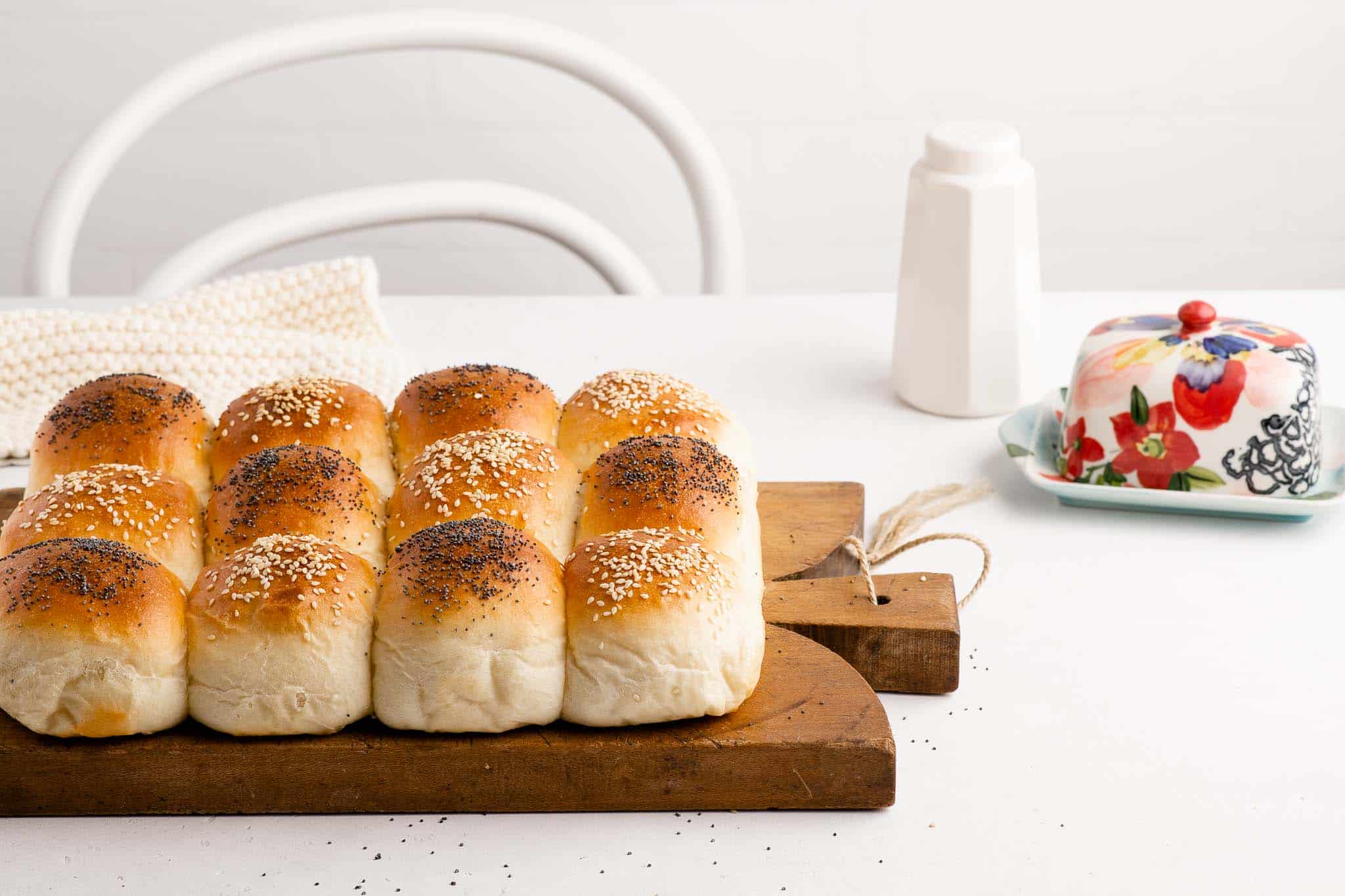
Soft Bread Rolls
As a child, my parents owned a busy bakery in Australia. Like many Vietnamese businesses, it was open 7 days a week, 365 days a year. When I wasn’t at school, you could find me earning my pocket money at the bakery, whether serving customers behind the counters, slicing and bagging loaves of bread, decorating the “easy” cakes, or sweeping up breadcrumbs (an endless, fruitless task).
It was also my job to bag the bread rolls, often 6 rolls at a time. This served a dual purpose of keeping the buns fresher and softer for longer, but it also enticed customers to buy the rolls in units of 6. My mother was a smart businesswoman 😉

White Bread Rolls
Since moving to Switzerland, I have been a little disappointed to not find similar soft white bread rolls here, although I have found other types of bread which I like very much. The Swiss (and Europeans in general) prefer bread with a harder and chewier crust (such as the jaw-breaking Bürlibrot), and there is little available in the way of soft white bread rolls which are not brioche, unless you are after hot dog buns or similarly highly-processed buns.
I like to make these white bread rolls to go with hamburgers, mostly because this is the sort of bread I grew up eating at any Aussie barbecue. Back then, there were no such thing as soft and squishy American-style burger buns.
In recent years, the supermarkets in Switzerland have started to sell brioche hamburger buns, but I find them too sweet (and too highly processed) for my tastes. Call me old-fashioned, but I just want a normal white bun for my hamburgers – nothing buttery, nothing fancy.
Which is why these bread rolls are perfect. They taste just like the white rolls which my parents sold in their bakery (which is, in itself, a comfort factor for me), and they are great for those recipes where you need a nice, soft and fluffy bread roll.
Bread Roll Recipe
Below is my go-to recipe for soft and fluffy bread rolls which are perfect for tearing and sharing. The rolls are baked close together to allow them to rise and form tall bread rolls with a tenderly soft and pillowy centre.
If you are looking for soft dinner rolls, rolls for making sandwiches or hamburgers, or just soft bread rolls in general, this is the recipe you need.
These bread rolls taste just like bakery-style white bread rolls. The dough is slightly enriched with milk and butter to make the dough soft and pillowy.
This recipe can be used to make 9 hamburger-sized buns, 12 dinner rolls, or 15 mini dinner rolls.

How to Make Soft Bread Rolls
Step 1
Measure the flour, sugar, yeast and salt into the bowl of an electric stand mixer. Lightly mix the ingredients together.
Step 2
Slowly add the warm milk (you may not need all of it), and lightly beat everything with the dough hook until it comes together into a large ball of dough. Only add as much milk as you need to bring the ingredients together into a dough.

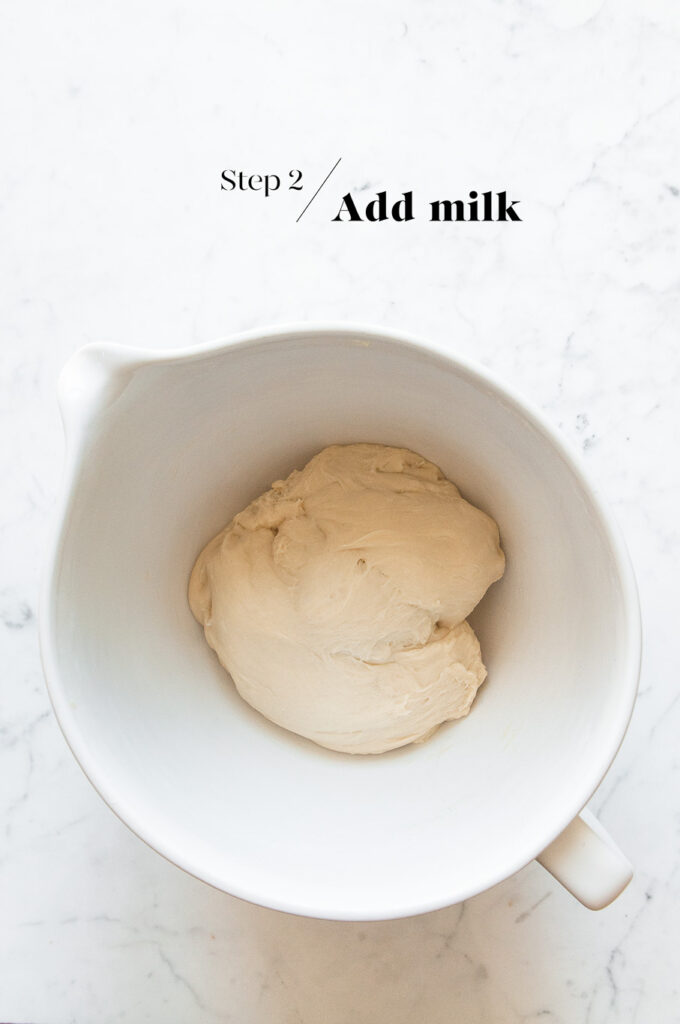
Step 3
Slowly incorporate the butter, one tablespoon at a time, until all of the butter has been used.
Then increase the speed to medium and continue kneading with the dough hook for 15 to 20 minutes, or until the dough is smooth and elastic.
Step 4
Lightly oil a large mixing bowl, and place the dough into the bowl. Cover the bowl with a clean tea towel and leave it somewhere warm for 1 to 1.5 hours, or until the dough has doubled in size.
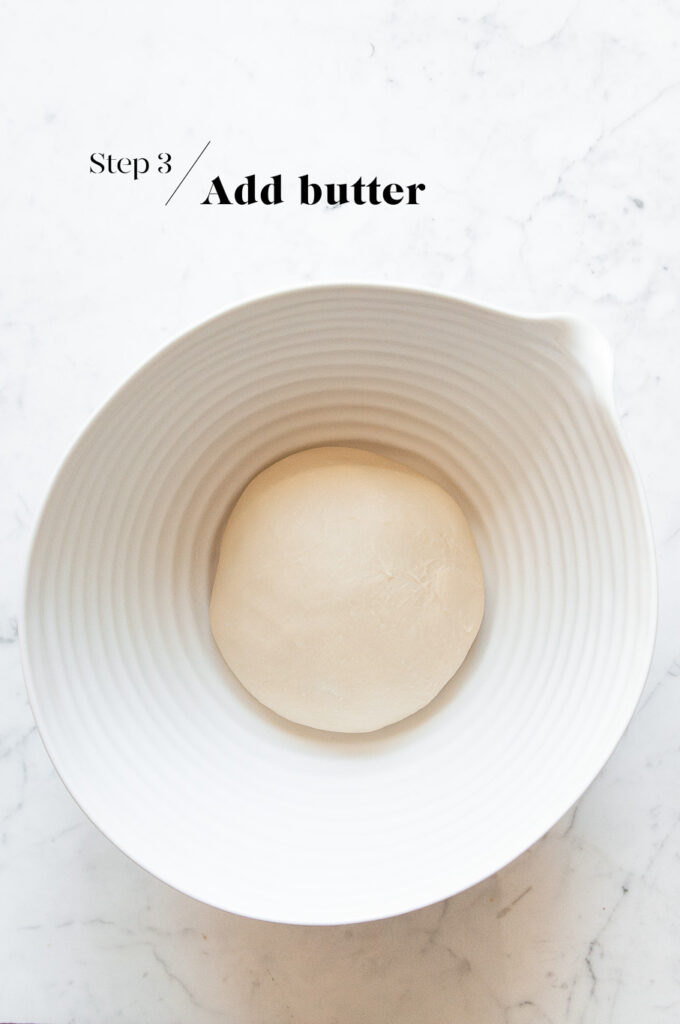
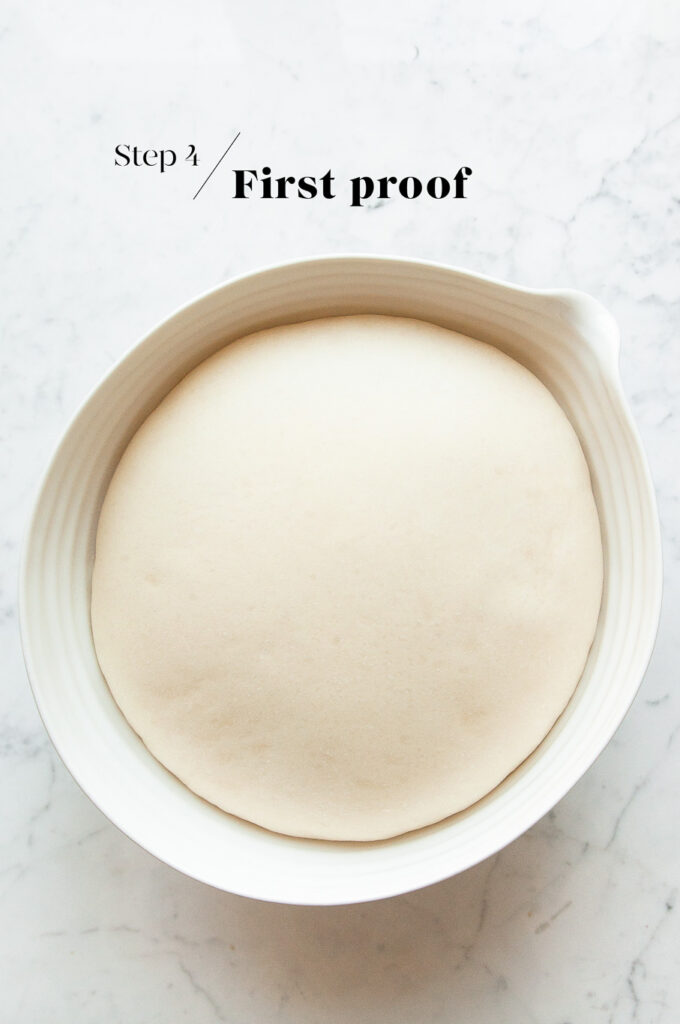
Step 5
Once the dough has doubled in size, gently remove the dough from the bowl. The dough will deflate as you handle it.
Cut the dough into 12 equal portions. I like to do this by weighing the dough, and then dividing this number by 12 to get the weight for each ball of dough.
Roll each piece of dough into a smooth ball by pulling the edges together to form a ball, pinch the edges together, and roll gently until you have a smooth ball.
Place the balls of dough onto a lined baking tray. Place the buns somewhat close together so that they will touch each other after the second proofing.
Step 6
Place the tray of buns somewhere warm for about 30 minutes to puff up slightly. Note that, during baking, the buns will rise and expand even more.

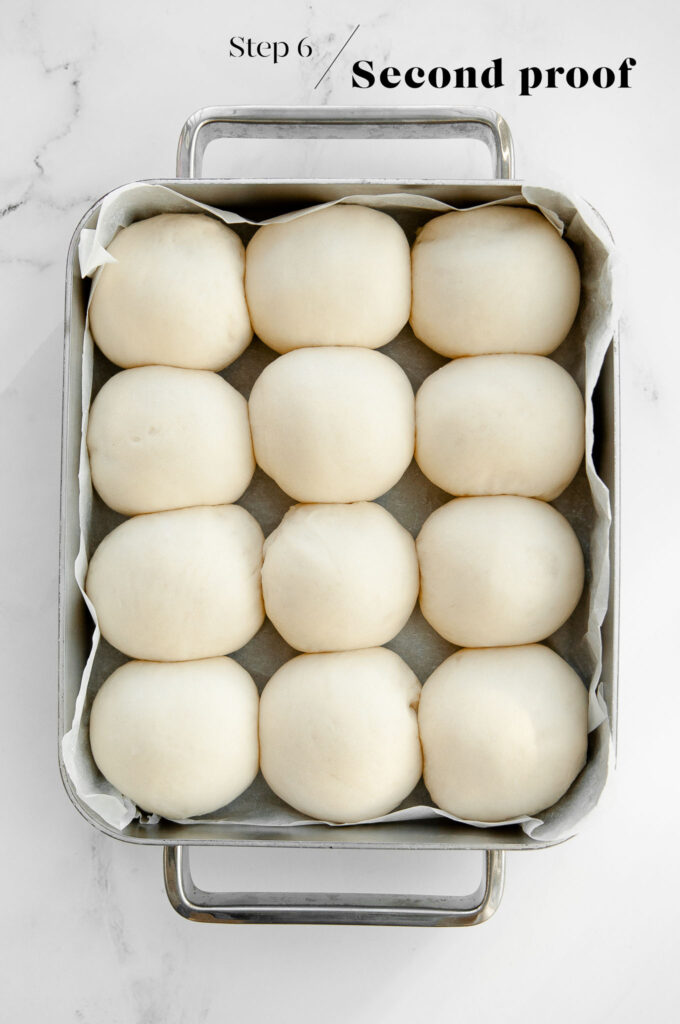
Step 7
Preheat the oven to 220°C/390°F (without fan). Place a metal baking tray in the middle of the oven.
Brush the buns with some milk and sprinkle with sesame seeds and/or poppy seeds.
Bake the buns for 10 minutes.
Step 8
Reduce the oven temperature to 180°C/356°F (without fan).
Continue baking for 15 minutes, or until the bread rolls are nice and golden.
If the bread rolls are browning too quickly, loosely cover them with the a sheet of aluminium foil for the rest of the baking time. I generally find that I have to cover the buns with foil after 10-12 minutes of baking (from the start).

Tips for Making Bread Rolls
- Bake the rolls close together. For soft and fluffy buns, they need to be baked close together so that they can rise sufficiently in the oven. The taller the buns, the softer they will be.
- Make the dough the night before. Get a head start by making the dough the night before. Once the dough has had its first session of proofing, place the covered bowl into the fridge. The dough will continue to rise slightly overnight in the fridge, so make sure your bowl is big enough. The next day, portion the dough and continue with the rest of the recipe. As the dough will be cold from the fridge, the second proofing may take slightly longer. Theoretically, you can also portion the dough and leave the buns to proof overnight in the fridge. However, I find that sometimes the dough can proof too much overnight. For almost all types of bread, I prefer to keep an eye on the dough during the second proofing.
Soft Bread Rolls

- Resting Time: 2 hours
- Prep Time: 45 mins
- Cook Time: 30 mins
- Total Time: 1 hour 15 minutes
- Yield: Makes 12 bread rolls
- Category: Bread
- Method: Oven
- Cuisine: Australian
These soft and fluffy bread rolls are perfect for hamburgers, sandwiches, dinner rolls, or anytime you want a soft white roll. Recipe for soft bread rolls with step-by-step photos.
Ingredients
For the Dough
- 500 g (3 1/3 cup) strong white bread flour
- 1 1/2 teaspoons fine salt
- 2 tablespoons caster sugar
- 7 g (2 teaspoons) instant yeast (see Kitchen Notes)
- 300 ml (1 cup plus 3 tablespoons) full cream milk (whole milk), warmed slightly to about 37°C/98°F
- 30 g (2 tablespoons) unsalted butter, softened
For the Bread Rolls
- 2 tablespoons full cream milk (whole milk)
- sesame seeds, for sprinkling (optional)
- poppy seeds, for sprinkling (optional)
Instructions
To Make the Dough
- Measure the flour, salt, sugar and yeast into the bowl of an electric stand mixer, fitted with a dough hook.
- Lightly mix the ingredients together.
- With the speed on low, slowly add the warmed milk.
- Keep mixing on low speed until the ingredients come together into a sticky dough.
- Add the butter, about a tablespoon at a time, waiting for it to be completely incorporated before adding the next tablespoon.
- Once all of the dough ingredients have been added, mix the dough on a low-medium speed for about 15-20 minutes, or until you have a soft and smooth ball of dough. When you poke the dough gently, it should bounce back immediately.
- Lightly oil a large bowl.
- Place the dough into the bowl, and cover with some plastic wrap or a reusable bowl cover.
- Leave the dough somewhere warm for 1 to 1.5 hours, or until the dough has doubled in size (see Kitchen Notes below).
To Portion the Bread Rolls
- Remove the dough gently from the bowl.
- Weigh the dough and divide this number by 12 to get the weight for each bun.
- Divide the dough into 12 equal portions.
To Shape the Bread Rolls
- Line a large, high-sided baking tray with baking paper.
- Roll each piece of dough into a smooth ball by pulling the edges together to form a ball, pinch the edges together, and roll gently until you have a smooth ball.
- Place the buns somewhat close together on the baking tray so that they will touch each other after the second proofing.
- Place the tray of buns somewhere warm for about 30 minutes to puff up slightly.
To Bake
- Preheat the oven to 220°C/390°F (without fan).
- Brush the bread rolls with some milk.
- Sprinkle the bread rolls with sesame seeds and/or poppy seeds (optional).
- Bake the bread rolls for 10 minutes.
- Reduce the oven temperature to 180°C/356°F (without fan).
- Continue baking the bread rolls for another 10-15 minutes. If the bread rolls are browning too quickly, cover them loosely with a sheet of aluminium foil for the remainder of the baking time.
- The bread rolls are cooked if an internal thermometer reads 85°C/185°F.
- Carefully remove the bread rolls from the tray.
- Let the bread rolls cool on a wire rack. If you leave them on the baking tray or baking paper, the buns will steam on the bottom and get a little soggy.
- Serve warm or cool.
Kitchen Notes
 VARIATIONS
VARIATIONS
This recipe makes 9 hamburger-sized buns, 12 dinner rolls, or 15 mini dinner rolls.
 LEFTOVERS
LEFTOVERS
Just like my parents did in the bakery, any leftover bread rolls should be kept in a sealed plastic bag (such as a ziplock bag), and they will remain soft and fresh for several days.
 DIFFERENT TYPES OF FLOUR
DIFFERENT TYPES OF FLOUR
* For Swiss readers: I use Zopfmehl (or farine pour tresse) when making bread and enriched dough.
 DIFFERENT TYPES OF YEAST
DIFFERENT TYPES OF YEAST
* Please note that there is a difference between instant yeast (also called instant dried yeast or fast-action dried yeast) and dried yeast (also called active dry yeast). If you are not sure what type of yeast you have, please check the packaging for instructions on how to use the yeast.
* With instant yeast, you can add it directly to the flour mixture without having to activate it first.
* With dried yeast, you will need to activate it first (usually in some warm liquid).
* If you are using fresh yeast, you will need about half a block (20 g fresh yeast = 7 g instant yeast). Crumble the fresh yeast into the warm milk, and stir to dissolve the yeast.
 PROOFING THE DOUGH
PROOFING THE DOUGH
Dough needs a warm environment for the yeast to activate and cause the dough to rise. If you don’t have a warm place in your home, try one of the following ideas:
* In the oven with the oven light switched on (works only for some ovens).
* In the oven with a tray of boiling water on the bottom shelf.
* In the oven or a steamer oven at a low temperature of about 25-40°C (77-104°F).
 OVEN TEMPERATURES
OVEN TEMPERATURES
All recipes on this website state temperatures for a regular oven (i.e. a conventional oven without fan). If you have a convection oven with a fan, please consult the manufacturer’s handbook on how to adjust the temperature and baking time accordingly.
 CONVERSIONS
CONVERSIONS
To convert from cups to grams, and vice-versa, please see this handy Conversion Chart for Basic Ingredients.
 Print
Print Pin Recipe
Pin Recipe Rate
Rate
Fantastic recipe! Just made these for our bbq dinner and they taste better than the rolls from the bakery.
I used your recipe to make 9 hamburger buns and they tasted wonderful. They were so delicious warm from the oven!